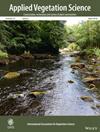Soil Nutrients Mediate Initial Intraannual Community Dynamics in a Tilled Grassland
Abstract
Questions
Grassland conversion to agriculture is a major driver of plant biodiversity loss. Repeated soil disturbances (e.g., tilling) and nutrient application (e.g., fertilization) common in many agricultural practices are thought to impose barriers limiting initial community reassembly. We experimentally disturbed and applied nutrients in a remnant tallgrass prairie to determine how these drivers influenced growing season trajectory of plant species richness and community composition.
Location
Texas Blackland Prairie remnant grassland, Southern Great Plains, USA.
Methods
We performed annual tilling and nutrient addition with a combination of nitrogen (N), phosphorus (P), and potassium (K) in a full-factorial experiment that included (n = 5 per treatment): untreated controls (C), nutrient addition only (NPKμ), tilling only (D), and tilling plus nutrient addition (NPKμ + D). Plant species cover was surveyed monthly during two growing seasons to determine plant species richness and composition change. Differences in community composition among treatments were identified by ordination.
Results
After 2 years of monthly growing season (April–August) plant community sampling, we found that species richness was significantly lower in tilled plots compared to untilled plots. The plant community in the D and NPKμ + D treatment shifted toward annual forb dominance, whereas populations of perennial grasses and forbs persisted in the C and NPKμ treatment. Annual forb dominance was most pronounced in the NPKμ + D treatment, where Ambrosia trifida established in near monocultures and seemingly prevented colonization of other species throughout the growing season. In these plots, species loss was greatest, whereas species gains and rates of composition change were lowest throughout the growing season.
Conclusions
Our results show annual soil disturbance and nutrient addition controlled the trajectory of growing season plant species richness and community composition by favoring a single dominant annual forb in near-monoculture, which prevented colonization by other species. The early application of practices that reduce soil nutrient availability and increase desired species propagule sources may be needed to prevent monoculture establishment and increase intraannual grassland plant diversity.


 求助内容:
求助内容: 应助结果提醒方式:
应助结果提醒方式:


